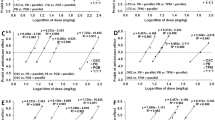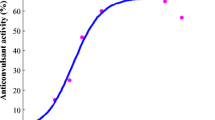Abstract
The anticonvulsant effects of lamotrigine (LTG) and clonazepam (CZP) and combinations thereof against maximal electroshock (MES)-induced seizures in mice were investigated using three-dimensional (3D) isobolographic analysis. With this method, the doses of fixed-ratio combinations of the drugs (1:3, 1:1 and 3:1) that elicited 16, 50 and 84% of the maximum anticonvulsant effect were determined. Additionally, to evaluate the characteristics of interactions observed with 3D isobolography, the brain concentrations of both drugs were verified pharmacokinetically. The 3D isobolographic analysis showed that LTG and CZP combined at the fixed ratios of 3:1 and 1:1 interacted synergistically in the MES test for all anticonvulsant effects between 16% and 84% of maximum. In contrast, the combination of LTG and CZP at the fixed ratio of 1:3 showed only pure additivity for all estimated effects in 3D isobolography. Moreover, none of the examined antiepileptic drugs altered the brain concentrations of the coadministered drug, so the observed interactions in the MES test are of a pharmacodynamic nature. The 3D isobolographic findings suggest that in epilepsy therapy, increased efficacy of seizure control (synergistic interaction) might be achieved by using LTG and CZP in combination. In this study, some important problems and assumptions related to statistical analysis of data in 3D isobolography are discussed.




Similar content being viewed by others
References
Berenbaum MC (1989) What is synergy? Pharmacol Rev 41:93–141 [Erratum in Pharmacol Rev 41:422 (1990)]
Besag FM, Berry DJ, Pool F, Newbery JE, Subel B (1998) Carbamazepine toxicity with lamotrigine: pharmacokinetic or pharmacodynamic interaction? Epilepsia 39:183–187
Borowicz KK, Swiader M, Luszczki J, Czuczwar SJ (2002) Effect of gabapentin on the anticonvulsant activity of antiepileptic drugs against electroconvulsions in mice—an isobolographic analysis. Epilepsia 43:956–963
Cadart M, Marchand S, Pariat C, Bouquet S, Couet W (2002) Ignoring pharmacokinetics may lead to isoboles misinterpretation: illustration with the norfloxacin-theophylline convulsant interaction in rats. Pharm Res 19:209–214
Calabresi P, Centonze D, Marfia GA, Pisani A, Bernardi G (1999) An in vitro electrophysiological study on the effects of phenytoin, lamotrigine and gabapentin on striatal neurons. Br J Pharmacol 126:689–696
Cheung H, Kamp D, Harris E (1992) An in vitro investigation of the action of lamotrigine on neuronal voltage-activated sodium channels. Epilepsy Res 13:107–112
Deckers CL, Czuczwar SJ, Hekster YA, Keyser A, Kubova H, Meinardi H, Patsalos PN, Renier WO, Van Rijn CM (2000) Selection of antiepileptic drug polytherapy based on mechanisms of action: the evidence reviewed. Epilepsia 41:1364–1374
Fischer RS (1989) Animal models of the epilepsies. Brain Res Rev 14:245–278
Gasior M, Ungard JT, Witkin JM (1999) Preclinical evaluation of newly approved and potential antiepileptic drugs against cocaine-induced seizures. J Pharmacol Exp Ther 290:1148–1156
Gebhart GF (1992) Topical reviews: a new type of report in pain. Pain 49:1
Gessner PK (1995) Isobolographic analysis of interactions: an update on applications and utility. Toxicology 105:161–179
Glantz SA, Slinker BK (2001) Primer of applied regression and analysis of variance, 2nd edn. MacGraw-Hill, New York
Greco WR, Bravo G, Parsons JC (1995) The search for synergy: a critical review from response surface perspective. Pharmacol Rev 47:331–385
Haefely W (1989) Benzodiazepines. Mechanisms of action. In: Levy R, Mattson R, Meldrum B, Penry JK, Dreifuss FE (eds) Antiepileptic drugs, 3rd edn. Raven, New York, pp 721–734
Jozwiak S, Terczynski A (2000) Open study evaluating lamotrigine efficacy and safety in add-on treatment and consecutive monotherapy in patients with carbamazepine- or valproate-resistant epilepsy. Seizure 9:486–492
Kanzawa F, Nishio K, Fukuoka K, Fukuda M, Kunimoto T, Saijo N (1997) Evaluation of synergism by a novel three-dimensional model for the combined action of cisplatin and etoposide on the growth of a human small-cell lung-cancer cell line, SBC-3. Int J Cancer 71:311–319
Leach MJ, Baxter MG, Critchley MA (1991) Neurochemical and behavioral aspects of lamotrigine. Epilepsia 32 (Suppl 2):S4–S8
Litchfield JT, Wilcoxon F (1949) A simplified method of evaluating dose-effect experiments. J Pharmacol Exp Ther 96:99–113
Loewe S (1953) The problem of synergism and antagonism of combined drugs. Arzneimittelforschung 3:285–290
Löscher W, Schmidt D (1988) Which animal models should be used in the search for new antiepileptic drugs? A proposal based on experimental and clinical considerations. Epilepsy Res 2:145–181
Löscher W, Fassbender CP, Nolting B (1991) The role of technical, biological and pharmacological factors in the laboratory evaluation of anticonvulsant drugs. II. Maximal electroshock seizure models. Epilepsy Res 8:79–94
Luszczki JJ, Czuczwar SJ (2003) Isobolographic and subthreshold methods in the detection of interactions between oxcarbazepine and conventional antiepileptics-a comparative study. Epilepsy Res 56:27–42
Luszczki JJ, Czuczwar SJ (2004) Isobolographic profile of interactions between tiagabine and gabapentin: a preclinical study. Naunyn-Schmiedeberg’s Arch Pharmacol 369:434–446
Luszczki JJ, Czuczwar M, Kis J, Krysa J, Pasztelan I, Swiader M, Czuczwar SJ (2003a) Interactions of lamotrigine with topiramate and first-generation antiepileptic drugs in the maximal electroshock test in mice: an isobolographic analysis. Epilepsia 44:1003–1013
Luszczki JJ, Borowicz KK, Swiader M, Czuczwar SJ (2003b) Interactions between oxcarbazepine and conventional antiepileptic drugs in the maximal electroshock test in mice: an isobolographic analysis. Epilepsia 44:489–499
Luszczki JJ, Swiader M, Czuczwar M, Kis J, Czuczwar SJ (2003c) Interactions of tiagabine with some antiepileptics in the maximal electroshock in mice. Pharmacol Biochem Behav 75:319–327
Macdonald RL (2002) Benzodiazepine. Mechanisms of action. In: Levy RH, Mattson RH, Meldrum BS, Perucca E (eds) Antiepileptic drugs, 5th edn. Lippincott, Philadelphia, pp 179–186
McLean MJ, Macdonald RL (1988) Benzodiazepines, but not beta carbolines, limit high frequency repetitive firing of action potentials of spinal cord neurons in cell culture. J Pharmacol Exp Ther 244:789–795
Pöch G (1993) Combined effects of drugs and toxic agents. Modern evaluation in theory and practice. Springer, Wien
Porreca F, Jiang Q, Tallarida RJ (1990) Modulation of morphine antinociception by peripheral [Leu5]enkephalin: a synergistic interaction. Eur J Pharmacol 179:463–468
Prichard MN, Prichard LE, Baguley WA, Nassiri MR, Shipman C (1991) Three-dimensional analysis of the synergistic cytotoxicity of gancyclovir and zidovudine. Antimicrob Agents Chemother 35:1060–1065
Prichard MN, Prichard LE, Shipman C (1993) Strategic design and tree-dimensional analysis of antiviral drug combinations. Antimicrob Agents Chemother 37:540–545
Stephen LJ, Brodie MJ (2002) Seizure freedom with more than one antiepileptic drug. Seizure 11:349–351
Sühnel J (1992) Zero interaction response surfaces, interaction functions and difference response surfaces for combinations of biologically active agents. Arzneimittelforschung 42:1251–1258
Sühnel J (1998) Parallel dose-response curves in combination experiments. Bull Math Biol 60:197–213
Tallarida RJ (1992) Statistical analysis of drug combinations for synergism. Pain 49:93–97
Tallarida RJ (2000) Drug synergism and dose-effect data analysis. Chapman & Hall/CRC, Boca Raton
Tallarida RJ (2001) Drug synergism: its detection and applications. J Pharmcol Exp Ther 298:865–872
Tallarida RJ (2002) The interaction index: a measure of drug synergism. Pain 98:163–168
Tallarida RJ, Stone DJ, McCary JD, Raffa RB (1999) Response surface analysis of synergism between morphine and clonidine. J Pharmcol Exp Ther 289:8–13
Wang SJ, Huang CC, Hsu KS, Tsai JJ, Gean PW (1996) Inhibition of N-type calcium currents by lamotrigine in rat amygdala neurones. Neuroreport 7:3037–3040
Wang SJ, Tsai JJ, Gean PW (1998) Lamotrigine inhibits depolarization-evoked Ca++ influx in dissociated amygdala neurons. Synapse 29:355–362
White HS, Woodhead JH, Wilcox KS, Stables JP, Kupferberg HJ, Wolf HH (2002) Discovery and preclinical development of antiepileptic drugs. In: Levy RH, Mattson RH, Meldrum BS, Perucca E (eds) Antiepileptic drugs, 5th edn. Lippincott, Philadelphia, pp 36–48
Acknowledgments
This study was supported by a grant (PW 447/2002-2004) from the Skubiszewski Medical University of Lublin. The authors thank Mr W. Zgrajka (Institute of Agricultural Medicine, Lublin, Poland) for the skilful determination of the brain concentrations of LTG. Dr J.J. Luszczki is a recipient of the Fellowship for Young Researchers from the Foundation for Polish Science.
Author information
Authors and Affiliations
Corresponding author
Rights and permissions
About this article
Cite this article
Luszczki, J.J., Czuczwar, S.J. Three-dimensional isobolographic analysis of interactions between lamotrigine and clonazepam in maximal electroshock-induced seizures in mice. Naunyn-Schmiedeberg's Arch Pharmacol 370, 369–380 (2004). https://doi.org/10.1007/s00210-004-0983-9
Received:
Accepted:
Published:
Issue Date:
DOI: https://doi.org/10.1007/s00210-004-0983-9




